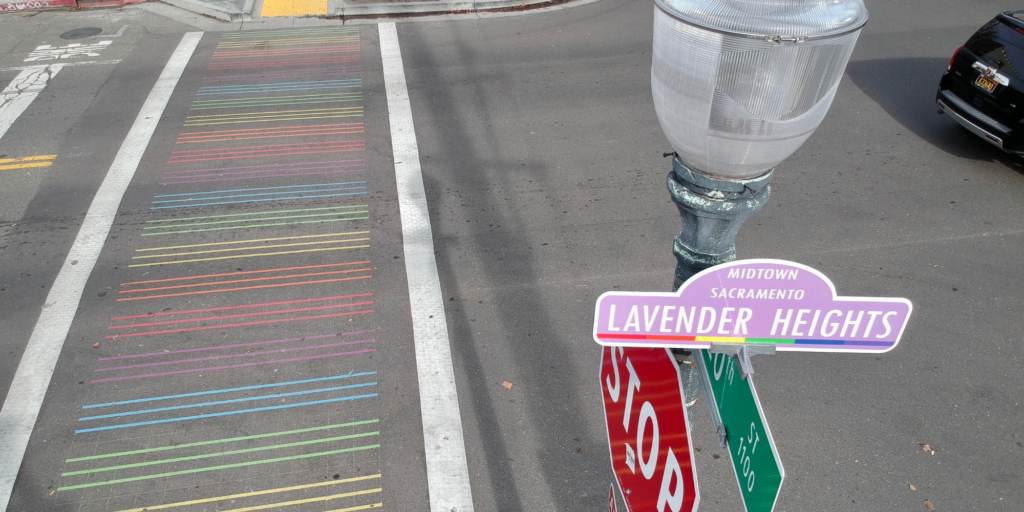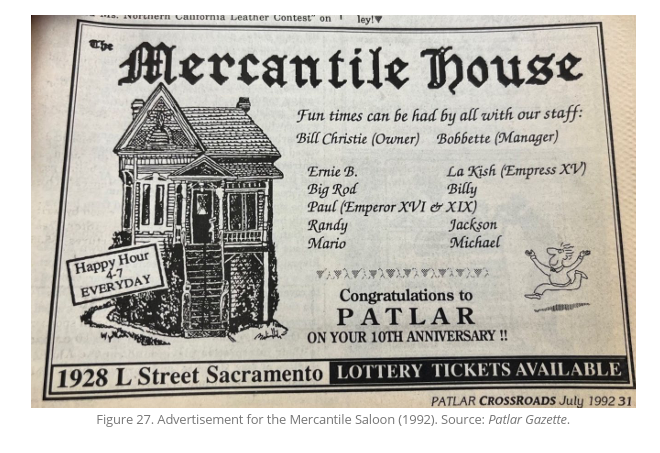From Hidden to Historic: LGBTQ+ Life in Sacramento
May 30th, 2025

Discover the Legacy of LGBTQ+ Life in Sacramento
Sacramento’s LGBTQ+ community has a rich history full of courage, culture, and connection. This blog explores that story, from diving into the important Historic Context Statement finalized in 2024, to learning more about the lively neighborhoods of Lavender Heights and Midtown; you’ll read about the early days of LGBTQ+ life in Sacramento, discover the heart of its vibrant community, and find out about local resources that keep it strong today.
LGBTQ+ Beginnings in Sacramento: A Look Through the Historic Context Statement
For decades, Sacramento’s LGBTQ+ community played an essential but often unrecognized role in shaping the cultural and social fabric of California’s capital. In 2023, the city took an important step toward honoring that legacy by receiving a grant to develop an LGBTQ+ Historic Context Statement (HCS). This comprehensive document was created to identify, preserve, and celebrate the people, places, and stories that have long defined LGBTQ+ life in Sacramento.
Drawing from archival research, oral histories, and firsthand accounts, the report brings Sacramento’s LGBTQ+ history into clearer focus.
This blog highlights some key historical moments captured in the Historic Context Statement related to the history of LGBTQ+ life in Sacramento and Midtown, but it only scratches the surface of the full research document. To explore the full report, including detailed narratives, historic sites, maps, and more, you can read the complete Historic Context Statement below.
Read Full Historic Context Statement Here
Highlights from the Sacramento LGBTQ+ Historic Experience Project:
LGBTQ+ identities have long been part of Sacramento’s story, even if they went unrecognized for much of the city’s official history. Among the area’s earliest inhabitants, indigenous groups such as the Nisenan, Miwok, and Patwin recognized and accepted diverse expressions of gender and sexuality. This inclusive worldview stood in contrast to the rigid norms imposed by European colonizers, whose arrival introduced laws and beliefs that condemned gender nonconformity, which persisted despite the Gold Rush’s gender imbalance.
Even amid persecution, LGBTQ+ expression found moments of celebration in the public sphere. In the 19th and early 20th centuries, Downtown Sacramento became known for its theatrical performances featuring male and female impersonators—early examples of gender fluidity being expressed and applauded on stage. These performances helped lay the groundwork for the more open and visible lgbtq+communities that would later emerge in neighborhoods like Midtown and Lavender Heights.
In the 1940s and 1950s, growing interest in medical and psychological research led to increased awareness of gender and sexual identities that challenged societal norms. This helped pave the way for some of the earliest gender non-conforming communities. However, the Cold War era brought a wave of fear and repression, resulting in heightened criminalization of LGBTQ+ individuals. In Sacramento, this atmosphere led to the formation of early support organizations like the Association for Responsible Citizenship (ARC) in the 1960s, which provided a safe space and community for gay men and women.

At the same time, ongoing discrimination and legal restrictions prompted LGBTQ+ people to create their own spaces outside of official scrutiny. Bars, businesses, and gathering places began to appear in West Sacramento, which was unincorporated at the time and therefore less tightly regulated. The LGBTQ+ community in Sacramento did not begin shifting from West Sacramento to Midtown til after the 1969 Stonewall riots and the 1975 repeal of California’s anti-sodomy laws.
Sacramento’s LGBTQ+ community remained largely underground until the late 1970s. In a 1978 article published by The Advocate, a national gay and lesbian magazine, a local resident described the city’s LGBTQ+ scene as being “deep beneath the surface,” reflecting the fear many people had about being openly identified. At the time, most gay and lesbian individuals stayed closeted to avoid social or professional consequences. Gary Miller, a former San Francisco resident who relocated to Sacramento, remarked that the city felt like it was a decade behind.”People still [did] not want to be known by their last names—even some of those participating in the organized gay community. They [were] paranoid about who [knew they were] gay.”
The emergence of a visible LGBTQ+ community in Sacramento during the late 1960s through the 1980s was shaped by a combination of social, economic, and cultural factors. As suburban development drew wealthier residents out of the city, housing in the Central City became more affordable. This drew in younger, single people—including many from the LGBTQ+ community—who were seeking a more welcoming and urban environment.
By the early 1970s, the intersection of P and 22nd Streets had become a local center of LGBTQ+ activity. In 1971, the Gay Alternative Coffeehouse opened at 2215 P Street in the apartment of Edgar Carpenter, a Sacramento State College student, LGBTQ+ rights advocate, and contributor to Gay Voice Sacramento. The coffeehouse served as a community gathering place and meeting spot for the Society for Homosexual Freedom (SHF), while also hosting gay community potlucks and informal events that helped foster connection among LGBTQ+ residents.
Around the same time, lesbian communities began to form spaces of their own. The S Street Collective, located at 1903 21st Street, offered communal living and support for newly arrived lesbians throughout the 1970s. These grassroots efforts laid the foundation for a more visible and cohesive LGBTQ+ presence. By the late 1970s and into the 1980s, LGBTQ+ life in Sacramento had become a more vibrant and recognized part of the city’s social and cultural landscape.

By 1982, an estimated 70,000 to 80,000 residents in Sacramento identified as gay. The Sacramento Bee highlighted the growing visibility of the community, noting that gay couples were becoming common in areas like Curtis Park and Land Park. While most gay residents lived in suburban areas, many also settled in the Central City, drawn by job opportunities, proximity to natural attractions, and the desire to avoid the pressures of larger cities like San Francisco or Los Angeles. Some relocated to Sacramento from areas where they faced discrimination, seeking greater acceptance. As the community grew, more gay-owned and gay-friendly businesses emerged, helping to establish a vibrant LGBTQ+ presence in the city.
By the early 1980s, Midtown Sacramento, particularly around the intersection of 20th and K streets, was becoming a center of gay nightlife. One of the first prominent venues was the Mercantile Saloon, also known as the Merc, which opened in 1976 at 1928 L Street in a converted Victorian house. The Merc played an important role in increasing the visibility of the LGBTQ+ community in the city. It became especially known for creating a welcoming space for gay Black men at a time when many other bars were not as inclusive. During the 1980s, under the management of Ernie Brown, the Merc became a vital gathering place for Sacramento’s gay Black community.

Another important bar in the area was The Western, located at 2001 K Street. Operating as a bar since 1938, it became The Western Pacific Depot after TJ Bruce and his mother Marjorie purchased it in 1997. The bar had developed a reputation for attracting older gay men and continued to serve as a cornerstone of Sacramento’s LGBTQ+ nightlife.
In 1985, Terry Sidie opened the gay bar Faces, aiming to create an inclusive space for all communities. The bar was named “Faces” to reflect its welcoming nature. Over the years, Faces became known for its vibrant atmosphere, featuring three dance floors, 16 bar stations, and an outdoor pool by 2015. The bar was also known for its rainbow-colored triangular sign, which read, “You are entering a gay bar! Respect us, and we’ll respect you!”

Today, all three bars—The Merc, The Depot, and Faces—remain open and continue to serve as key landmarks in Sacramento’s LGBTQ+ community.
This blog only scratches the surface of the Historic Context Statement. To explore Sacramento’s LGBTQ+ history in full detail—including historical maps, oral histories, and significant landmark sites—you can read the full report here.
History of Lavender Heights and Midtown
It is impossible to speak of LGBTQ+ history and culture in Midtown without mention of the Lavender Heights District. The neighborhood is rich with the history of Sacramento’s vibrant community; and attracts local and regional residents and tourists to the area’s many LGBTQIA+ owned clubs, restaurants, salons, galleries, and retail stores. Lavender Heights is located at the heart of Midtown at 20th and K Streets and is the home of our weekly Midtown Farmers Market. Below see a brief timeline of LGBTQ+ history from 1978 to today!
In 1978, just nine years after the Stonewall Riots, the Lambda Community Fund, now known as the Sacramento LGBT Community Center was originally incorporated as a special assistance program based in Midtown, Sacramento.
In 1984, Gay activist Rev. Jerry Sloan of Metropolitan Community Church (MCC) successfully sued Rev. Jerry Falwell in 1984 for televised comments Falwell made against MCC, Sloan used a portion of the money awarded to him to later open the first physical iteration of the SAC Center, Lambda Community Center.
In 1985, Faces Nightclub was the first gay club in Sacramento when it opened its doors at 20th and K Street. “When I opened it, it was where everyone who was gay could go, that was 33 years ago,” Faces owner Terry Sidie said, in an interview with ABC10 in 2017. The establishment of Faces paved the way for other LGBTQIA+ businesses to open in the immediate area, which earned its name Lavender Heights.
1986, the Lambda Community Center opened to serve the broader cross-section of the lesbian, gay, bisexual, and transgender community. Programs served LGBTQ+ people to lead self-sufficient, healthy, well-adjusted lives, and provided advocacy for issues of importance within the community.
In 1998, the Lavender Library was founded by eight community members as a research and information institution for LGBTQ+ people in Sacramento and continues operation today on 21st Street.
In 2001, the Rainbow Chamber of Commerce was founded to unify and support LGBTQ businesses, as well as to foster a more equitable business climate.
In 2015, Sacramento City Council member Steve Hansen, Sacramento’s first openly LGBTQ+ council member, invited the Sacramento Rainbow Chamber of Commerce to be part of a community coalition to pursue official city designation of the LGBTQ+ neighborhood of Midtown Sacramento historically known as Lavender Heights. The name Lavender Heights name became official in 2015, an achievement memorialized by the unveiling of the rainbow crosswalk at the intersection of 20th and K Street.
The rainbow crosswalks were designed as a celebration of the region’s LGBT community and are similar to those in other U.S. cities, including Philadelphia, San Francisco, Seattle, and West Hollywood. This project was a collaborative effort of the Midtown Association, the Rainbow Chamber of Commerce, and Councilmember Steve Hansen. The crosswalks are maintained and supported by the Midtown Association, which is committed to ensuring Midtown remains a thriving center for culture, creativity, and vibrancy.
In 2017, a documentary was released about a woman who founded the Sacramento LGBT Community Center (then called the Lambda Community Center) after bringing a successful lawsuit against a reverend. Titled “Legends of Courage: The Rosemary Metrailer Story” highlights actions leading up to the legal action against the Rev. Jerry Falwell, which led to the founding of the Center by Metrailer in 1984.
In 2019, the Sacramento LGBT Community Center moved into its forever home at 1015 20th street, in the heart of the Lavender Heights district. The Center continues to offer peer support groups for a variety of marginalized populations, community resource referrals to meet individual basic needs, education, and training to improve the competency of businesses and organizations to LGBTQ+ issues, numerous artistic expressions, and cultural activities that build community, and volunteer opportunities that empower individuals to give back.
In 2021, Midtown Association partnered with WEAVE Inc., The Sacramento LGBT Community Center, The Sacramento Rainbow Chamber of Commerce, Faces Nightclub, and Outword Magazine to launch PRIDE, Pronouns & Progress: Gender Inclusion Training, a new grant program and series of workshops for interested Midtown and Central City businesses. The free, hour-long inclusivity training sessions for grant recipients was led by WEAVE in a virtual format to focus on three primary topics: educating interested businesses about gender identities, gender rights in the workplace and beyond, and the importance of pronouns that go well beyond he/him/his and she/her/hers to include gender-neutral or inclusive pronouns. Due to strong community interest and engagement, the training led by WEAVE was brought back for in-person sessions in 2023 and 2024, further reinforcing Midtown’s commitment to fostering inclusive and welcoming environments for all.
In February 2022, as part of a partnership between Midtown Association and the Rainbow Chamber of Commerce, 10 vibrant new banners are now proudly displayed on 20th Street between J and K Streets — including in front of the Sacramento LGBT Community Center. The colorful banners were specially designed to demonstrate and celebrate #MidtownLove, acceptance, and inclusion in the heart of Lavender Heights. In addition to the banners on 20th Street, the new eye-catching and whimsical “Love is in our roots” rainbow vegetable art wraps were installed on utility boxes on 21st Street.

In 2022, new resources for LGBTQ people continue to emerge in the Lavender Heights district, most recently with the opening of the Lavender Courtyard in July 2022 to provide compassionate and affordable housing to LGBTQ seniors.
Today, Lavender Heights is home to weekly farmers markets and seasonal block parties and serves as the hub for Pride events to celebrate LGBTQIA+ culture and community. Amenities such as the rainbow crosswalks and public art further declare the neighborhood as a space for people to take pride in being unapologetically themselves.
LGBTQIA+ Resources
Sacramento LGBT Community Center: The Sacramento LGBT Community Center creates events, programs, and pathways to services that help lesbian, gay, bisexual, and transgender people feel welcome, needed, and safe. The Center’s website provides several links to community resources including Advocacy, Arts and Culture, Community, Social, Health & Wellness, and more.
Rainbow Chamber: The Sacramento Rainbow Chamber has a member directory of LGBTQ-owned and ally-owned businesses in Sacramento. If you are looking to support these businesses that give back to our community check out the directory!
Visit Sacramento: Visit Sacramento has featured LGBTQ+ friendly itineraries, blogs, and more for visitors and residents alike.
One Community Health: One Community Health is a non-profit health care provider serving the needs of the Sacramento Community. The center is a proven leader in LGBTQ health issues, including HIV and AIDS health issues, and is regarded as a safe space for LGBTQ community members to receive healthcare.
Outword Magazine: Outward Magazine is the leading LGBTQ magazine for Central and Northern California. For over 25 years, they have been producing content for LGBTQ+ locals that includes local LGBTQ+ news, events, and highlights of community members.
To learn more about Sacramento’s rich LGBTQ+ history and stay connected with the community, explore the full Historic Context Statement and get involved with local organizations. Join us in celebrating and supporting the vibrant culture that makes Midtown and Lavender Heights so unique!
